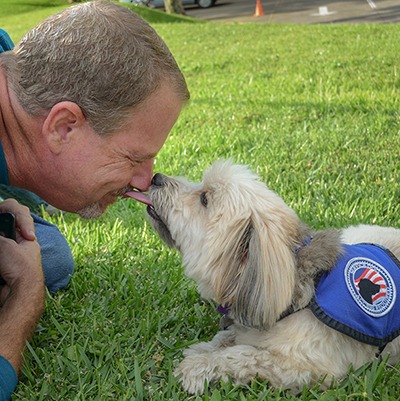ESA and PSD Training
Have YOUR Dog Trained to be an
Emotional Support Animal (ESA) or
Psychiatric Service Dog (PSD)
Have YOUR Dog Trained to be an
Emotional Support Animal (ESA) or
Psychiatric Service Dog (PSD)
Obedience and Emotional Support Animal (ESA) Four-week Program
Emotional Support Dog or well behaved dog-allowed in some stores, live with you in Federal housing, college campuses
Emotional Support Dog or well behaved dog-allowed in some stores, live with you in Federal housing, college campuses
ESA Cost $3,499

Obedience and Psychiatric Service Dog (PSD) Eight-week Program
Official Service Dog-Take Your Dog ANYWHERE with you-planes, restaurants, EVERYWHERE!
PSD Cost: $7,499
If you want your pet to stay or be trained at the BEST RESORT IN THE COUNTRY, make the beautiful drive or have us Pick Up and Deliver your pet in our Pet Chauf-Fur. $1 mile round trip for first pet-Additional pets ride free!
The rules for service dogs have recently changed. The new Department of Transportation (DOT) rules are as follows:
Difference between and ESA and a PSD Dog?
The difference between an ESA and PSD is how they provide support to their owners.
A PSD must be trained to perform tasks related to the owner’s disability. By contrast, ESAs do not require any specialized training. ESAs provide comfort for their owners just by being present during times of difficulty.
| EMOTIONAL SUPPORT ANIMAL VS PSYCHIATRIC SERVICE DOG |
What conditions qualify you for an ESA dog?
– Learning disorders
– Attention Deficit Disorder, also known as ADD
– Sexual disorder
– Mental retardation
– Tic disorders
– Motor skills disorders
– Bipolar disorder
– Gender identity
– Substance-related disorder (alcohol and/or drugs, among others)
– Cognitive disorders
– Attention Deficit Disorder, also known as ADD
– Sexual disorder
– Mental retardation
– Tic disorders
– Motor skills disorders
– Bipolar disorder
– Gender identity
– Substance-related disorder (alcohol and/or drugs, among others)
– Cognitive disorders
What conditions qualify you for a PSD dog?
– Post-Traumatic Stress Disorder (PTSD)
– Depression
– Anxiety Disorders
– Obsessive-Compulsive Disorder (OCD)
– Attention-Deficit/Hyperactivity Disorders
– Bipolar disorders
– Schizophrenia
– Claustrophobia
– Panic Disorders
– Autism
– Agoraphobia
– Depression
– Anxiety Disorders
– Obsessive-Compulsive Disorder (OCD)
– Attention-Deficit/Hyperactivity Disorders
– Bipolar disorders
– Schizophrenia
– Claustrophobia
– Panic Disorders
– Autism
– Agoraphobia
What would an ESA do for its owner?
The mere presence of the ESA dog provides comfort and support.
What would a PSD do for its owner?
– PSDs are used for an incredible variety of work, including the following:
– Reminding their handler to take medication
– Interrupting episodes such as crying, dissociation, flashbacks, and nightmares
– Interrupting harmful actions, such as scratching, picking, and self-harm
– Interrupting repetitive behaviors
– Providing pressure and tactile stimulation to calm
– Grounding and orienting the handler during panic attacks
– Lying on the handler during psychotic episodes
– Applying gentle pressure with teeth or nuzzling to disrupt psychiatric episodes
– Helping the handler maintain a stable routine
– Preventing the handler from oversleeping
– Reminding their handler to take medication
– Interrupting episodes such as crying, dissociation, flashbacks, and nightmares
– Interrupting harmful actions, such as scratching, picking, and self-harm
– Interrupting repetitive behaviors
– Providing pressure and tactile stimulation to calm
– Grounding and orienting the handler during panic attacks
– Lying on the handler during psychotic episodes
– Applying gentle pressure with teeth or nuzzling to disrupt psychiatric episodes
– Helping the handler maintain a stable routine
– Preventing the handler from oversleeping
How to identify your ESA or PSD Dog
ESA and PSD Dogs are not required to wear service vests and owners are not required to carry a card, however this may assist in identifying their service dog. The only two questions any public place can ask you are:
1. Is the dog a service animal required because of a disability?
2. What work or task has the dog been trained to perform? (in the case of a PSD Dog).
No one has the right to ask you to identify your specific disability or ask that your pet demonstrate their skill.
1. Is the dog a service animal required because of a disability?
2. What work or task has the dog been trained to perform? (in the case of a PSD Dog).
No one has the right to ask you to identify your specific disability or ask that your pet demonstrate their skill.

Ways to get ESA and PSD
– Ask your doctor to write a letter for you
– Get genuine certification online at Supportpets.com or Certapets.com
– Get genuine certification online at Supportpets.com or Certapets.com
Who gets certified, me or the dog?
YOU must become certified, not your dog. However, you must identify the dog you are working with, and the dog must be extremely well trained, or you can still be asked to leave.
Things that cause an ESA, PSD to be asked to leave:
Eliminating in an inappropriate place
Barking, whining, growling, biting
Eating or begging for food
Jumping on people
Sniffing or licking people or products
Disturbing other people
Barking, whining, growling, biting
Eating or begging for food
Jumping on people
Sniffing or licking people or products
Disturbing other people
What does the average ESA dog cost?
The training required to have an animal behave in public is typically about $3,500-$7,000.
What does the average PSD dog cost?
An animal from a service dog organization will have already received extensive training. The average cost of an animal from such an organization ranges from $15,000-$30,000.
Can my pet be my ESA or PSD Dog?
Yes! The ADA and the DOT permit owners to self-train their service animals. Using guidelines such as those provided by the General Public Access Test will enforce good behavior in your service dog when you’re visiting public spaces and are around other people. There’s also the option to get a service dog from a specialized service dog organization.
As previously mentioned, an animal from a service dog organization will have already received extensive training. However, the average cost of an animal from such an organization ranges from $15,000-$30,000.
The most popular option is to simply seek the services of a professional dog trainer. This is a preferable option for many who simply don’t have the time or energy to research training methods and best practices in addition to preparing a ‘curriculum’ for their service dog that meets guidelines like the General Public Access Test. A dog trainer brings years of experience and knowledge to the table and can more quickly teach your dog to perform all needed tasks, saving you the headache of doing it yourself. Working with a trainer can also help you and your service dog better understand each other’s body language and further build your bond. A trainer can also help you come up with appropriate signals to give your psychiatric service dog when you need a specific task performed.
As previously mentioned, an animal from a service dog organization will have already received extensive training. However, the average cost of an animal from such an organization ranges from $15,000-$30,000.
The most popular option is to simply seek the services of a professional dog trainer. This is a preferable option for many who simply don’t have the time or energy to research training methods and best practices in addition to preparing a ‘curriculum’ for their service dog that meets guidelines like the General Public Access Test. A dog trainer brings years of experience and knowledge to the table and can more quickly teach your dog to perform all needed tasks, saving you the headache of doing it yourself. Working with a trainer can also help you and your service dog better understand each other’s body language and further build your bond. A trainer can also help you come up with appropriate signals to give your psychiatric service dog when you need a specific task performed.
Why should I bother training my dog for this?
Taking an untrained dog into a public place is NOT a victimless crime.
An untrained dog can do irreparable damage that an untrained dog can do to the reputation of PSDs and ESAs. An incident like this could cause people with disabilities to lose their rights and privileges. By taking an untrained dog into a public place, you also endanger the dog. A dog that has not been properly trained may be frightened, which could cause it to bite someone. The unhappy result of that could be the dog being euthanized.
Taking an untrained dog into a public place can also cause damage to a business. No one wants to shop at a place where dogs are sniffing people and food, barking or eliminating on the floor. PSDs or ESAs who behave inappropriately by disrupting business, behaving aggressively, and interfering with other patrons can still be excluded from airlines, housing and public places.
An ESA/PSD dog must be unflappable AND have impeccable manners. Your dog must be socialized in a huge variety of situations so that he/she has enough experience to adapt or “bounce back” from new things that might trigger a fearful or aggressive response. Remember, dogs are animals, and they cannot vent their feelings the way people can. They don’t get to hire attorneys when they feel wronged or write letters to the editor. They simply react.
Your dog must be trained not to come into other people’s space, sniff them, lick, mouth or jump on them. They must not eliminate, jump on furniture or take food until invited. They must not get up on tables, counters, knock things over, bolt through doors or drag you on a leash. Your dog must learn to stay with you calmly and quietly.
Dogs get pretty messy at camp and dog grooming fee is not included. Consider
booking a dog grooming for your dog’s last day of stay to take home a clean pet.
booking a dog grooming for your dog’s last day of stay to take home a clean pet.



